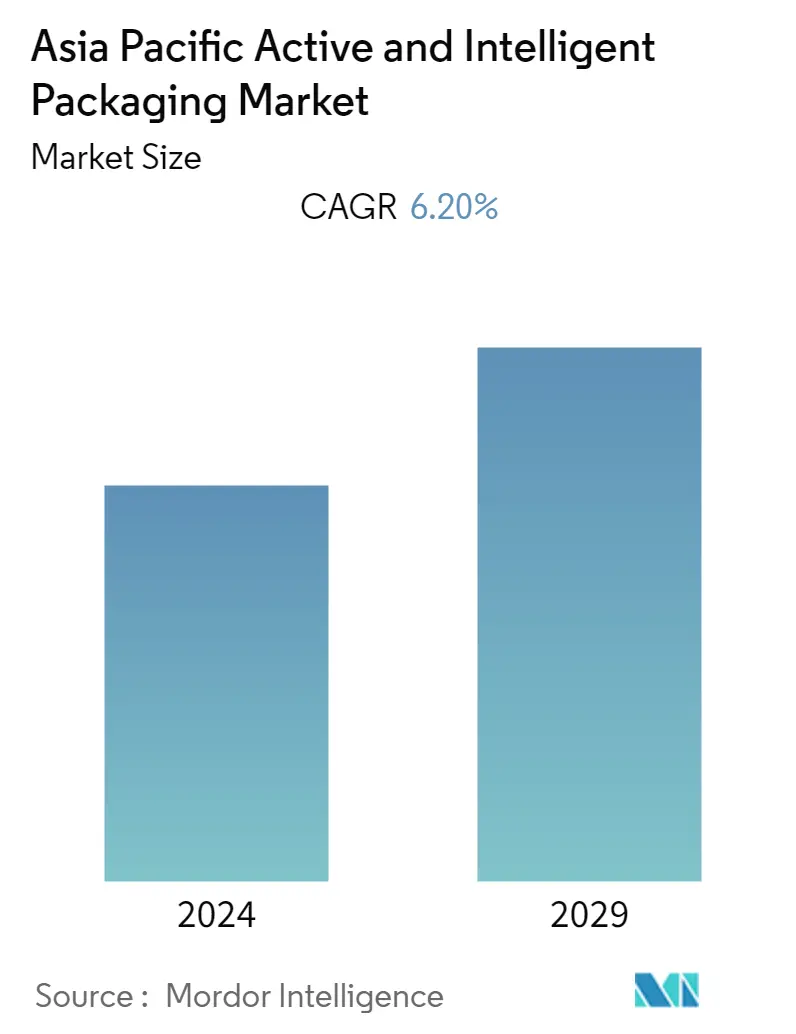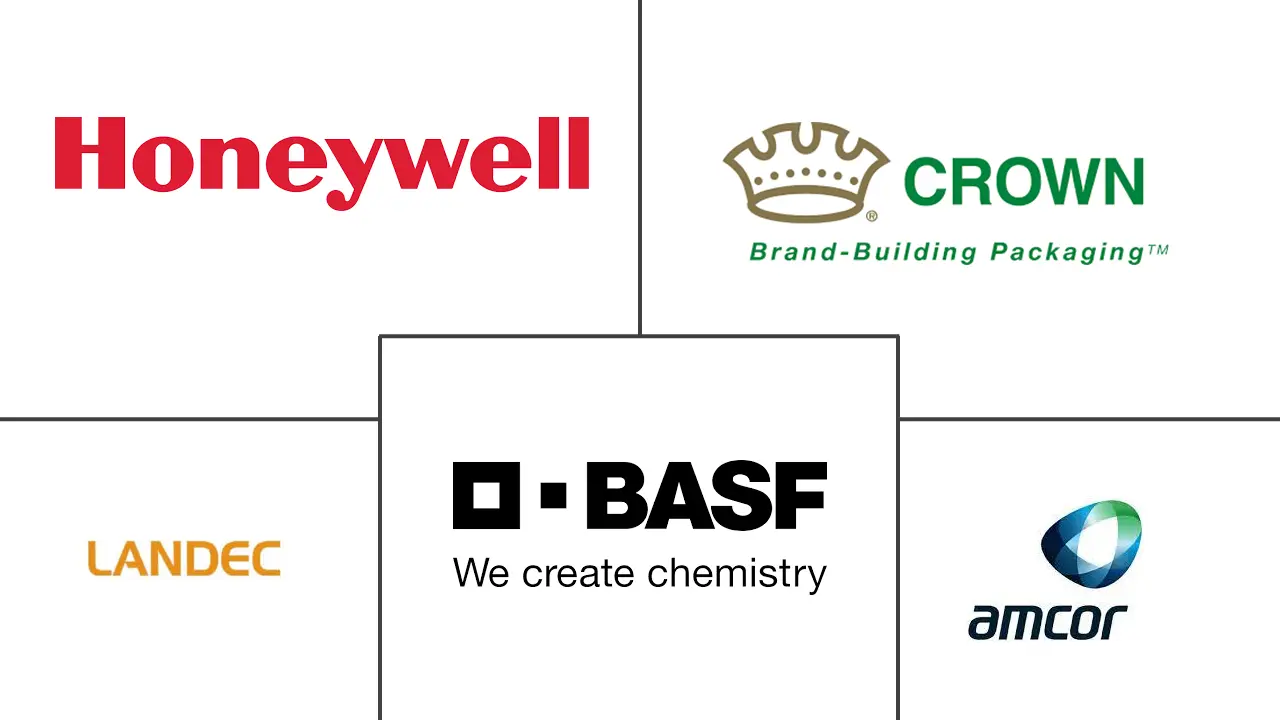Market Size of Asia Pacific Active and Intelligent Packaging Industry

| Study Period | 2019 - 2029 |
| Base Year For Estimation | 2023 |
| Forecast Data Period | 2024 - 2029 |
| Historical Data Period | 2019 - 2022 |
| CAGR | 6.20 % |
| Market Concentration | Medium |
Major Players
*Disclaimer: Major Players sorted in no particular order |
Asia Pacific Active and Intelligent Packaging Market Analysis
The Asia Pacific Active and Intelligent Packaging market is expected to register a CAGR of 6.2% over the forecast period (2021 - 2026). With the recent outbreak of COVID 19, the active and intelligent packaging manufacturers were flooded with a pool of issues that are expected to only last for the short term. Some of the effects of the lockdown include supply chain disruptions, lack of availability of raw materials used in the manufacturing process, labor shortages, fluctuating prices that could cause the final product's production to inflate and go beyond budget, and shipping problems.
- The growing geriatric population, rising number of chronic ailments, and increased demand for over-the-counter pharmaceuticals contribute to the Healthcare segment's growth. Active packaging solutions are becoming more popular as pharmaceutical packaging rules become more stringent. The market for active packages is expected to grow throughout the projected period, owing to the increasing complexity of products that must be stored or transferred to remote locations while keeping their integrity.
- Due to market maturity, growth in demand for corrosion control packaging, desiccants, and microwave susceptors will be more moderate. However, when new products are introduced to execute these standard functions more efficiently, healthy increases will continue to be seen. New ecologically friendly corrosion control scavengers, for example, have been created, and desiccants are now integrated into pharmaceutical bottles or caps to provide moisture management.
- Time-temperature indicators, as well as smart labels and tags, are becoming more widespread. Although many of these devices were previously thought to be unneeded or prohibitively expensive, technological advancements that allow for low-cost printed electronics manufacture and the replacement of specialist electronic readers with smartphones will allow them to enter the mainstream. Recent legislation in the pharmaceutical and food industries, which forces manufacturers to make products safer and easier to recall, will push the rapid adoption of tracking-enabled or interactive packaging components.
- Although intelligent packaging is distinctly different from active packaging, the features of intelligent packaging enable the user to use it to check the effectiveness and integrity of active packaging systems, bringing added features and complementing each other. Intelligent packaging can be considered the enabler of the other packaging features that end-user industries can utilize, and in the process, help their customers offer quality products.
Asia Pacific Active and Intelligent Packaging Industry Segmentation
Active and intelligent packaging involves the use of permitted additives in packaging films, or within packaging containers, for the maintenance and extension of product shelf life. Active packaging allows packages to interact with food and the environment and plays a dynamic role in food preservation. The Asia Pacific Active and Intelligent Packaging Market is Segmented by Type (Active Packaging, Intelligent Packaging), by End-User Vertical (Food, Beverage, Healthcare, Personal Care), and by Country
| By Type | ||||||
| ||||||
|
| By End-user Vertical | |
| Food | |
| Beverage | |
| Healthcare | |
| Personal Care | |
| Other End-user Verticals |
| By Country | |
| China | |
| Japan | |
| India | |
| Rest of Asia Pacific |
Asia Pacific Active and Intelligent Packaging Market Size Summary
The Asia Pacific Active and Intelligent Packaging market is poised for significant growth, driven by the increasing demand for innovative packaging solutions across various sectors, particularly healthcare and pharmaceuticals. The market is experiencing a shift towards active packaging solutions due to stringent pharmaceutical packaging regulations and the need to maintain product integrity during storage and transportation. The adoption of intelligent packaging, including time-temperature indicators and smart labels, is gaining traction as technological advancements make these solutions more accessible and cost-effective. This trend is further supported by recent legislative changes in the pharmaceutical and food industries, which emphasize product safety and traceability. Despite challenges such as high costs and limited consumer awareness, the market is expected to expand as companies leverage these technologies to enhance product quality and consumer engagement.
The market landscape is moderately consolidated, with key players like BASF SE, Amcor Ltd, and Honeywell International Inc. actively investing in strategic partnerships and product innovations to capture a larger market share. The growing geriatric population and the rise in chronic ailments are contributing to the increased demand for over-the-counter pharmaceuticals, thereby boosting the healthcare segment. Additionally, the use of RFID technology in supply chain management is helping to combat counterfeiting and improve product tracking, particularly in the food and pharmaceutical industries. Companies are also focusing on sustainability, with initiatives aimed at making packaging solutions recyclable and reusable. These developments, coupled with the ongoing demand for flexible sterile packaging and serialization in the pharmaceutical sector, are expected to drive the market's growth in the coming years.
Asia Pacific Active and Intelligent Packaging Market Size - Table of Contents
-
1. MARKET INSIGHTS
-
1.1 Market Overview
-
1.2 Industry Value Chain Analysis
-
1.3 Industry Attractiveness - Porter's Five Forces Analysis
-
1.3.1 Bargaining Power of Suppliers
-
1.3.2 Bargaining Power of Consumers
-
1.3.3 Threat of New Entrants
-
1.3.4 Threat of Substitute Products
-
1.3.5 Intensity of Competitive Rivalry
-
-
1.4 Market Drivers
-
1.4.1 Longer Shelf Life and Changing Consumer Lifestyle
-
-
1.5 Market Challenges
-
1.5.1 Security and Privacy Issues in the Case of Intelligent Packaging
-
-
-
2. MARKET SEGMENTATION
-
2.1 By Type
-
2.1.1 Active Packaging
-
2.1.1.1 Gas Scavengers/Emitters
-
2.1.1.2 Moisture Scavenger
-
2.1.1.3 Microwave Susceptors
-
2.1.1.4 Other Active Packaging Technologies
-
-
2.1.2 Intelligent Packaging
-
2.1.2.1 Coding and Markings
-
2.1.2.2 Antenna (RFID and NFC)
-
2.1.2.3 Sensors and Output Devices
-
2.1.2.4 Other Intelligent Packaging Technologies
-
-
-
2.2 By End-user Vertical
-
2.2.1 Food
-
2.2.2 Beverage
-
2.2.3 Healthcare
-
2.2.4 Personal Care
-
2.2.5 Other End-user Verticals
-
-
2.3 By Country
-
2.3.1 China
-
2.3.2 Japan
-
2.3.3 India
-
2.3.4 Rest of Asia Pacific
-
-
Asia Pacific Active and Intelligent Packaging Market Size FAQs
What is the current Asia Pacific Active and Intelligent Packaging Market size?
The Asia Pacific Active and Intelligent Packaging Market is projected to register a CAGR of 6.20% during the forecast period (2024-2029)
Who are the key players in Asia Pacific Active and Intelligent Packaging Market?
Honeywell International Inc., Landec Corporation, Amcor Ltd, BASF SE and Crown Holdings Inc. are the major companies operating in the Asia Pacific Active and Intelligent Packaging Market.

